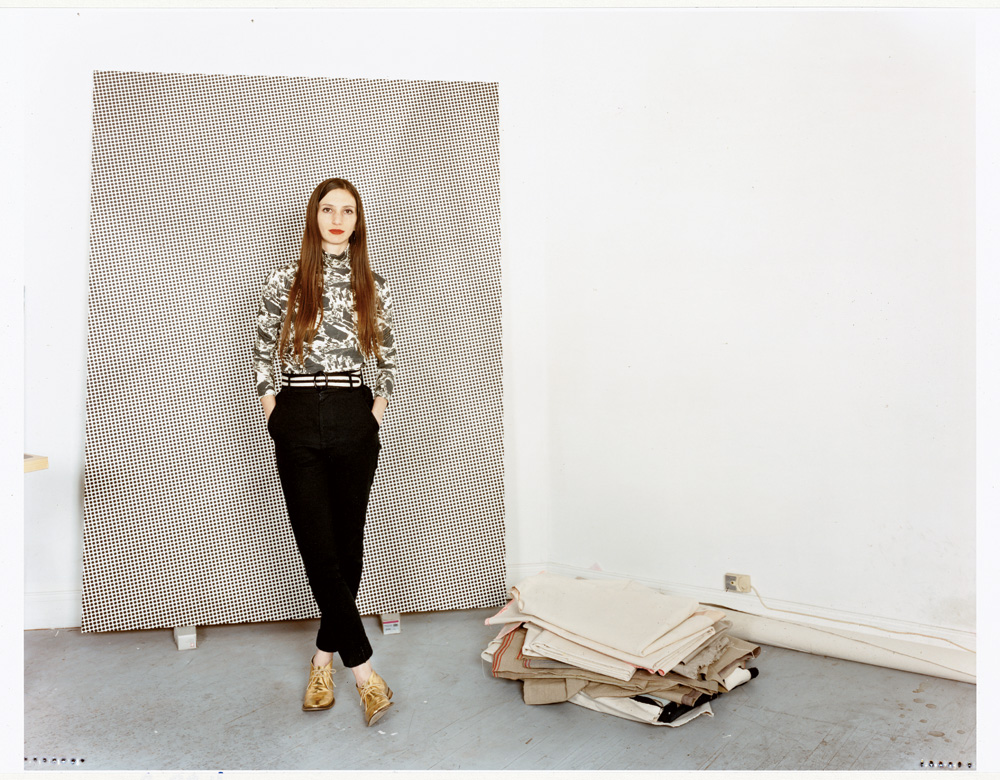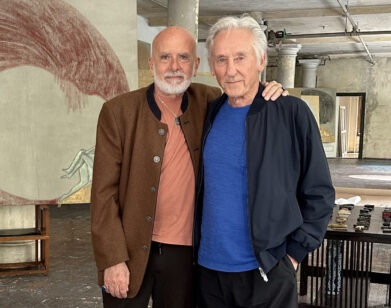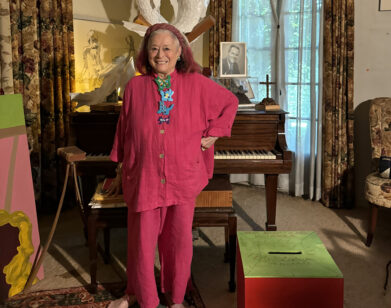Whitney Biennial
This spring’s Whitney Biennial marks the 75th anniversary of the polymorphous, polyphonic exhibition devoted to contemporary art in America—by no means a small marker for a show charged with shoring up our understanding of the art world’s current climate. Over the years, some of the finest curators have weighed in in the Biennial—as have many of the most prominent artists. But the very cultural weight of defining contemporary art in America might explain why, in recent decades, the Biennial has increasingly become a minefield of debate. Many have argued that it is impossible to delineate what “American” art is anymore, or that the very exercise of trying to establish some systematic answer is a futility bordering (alas, for the curator) on hubris. Others have said that the Biennialis too East- and West Coast–minded, toooriented toward New York City’s Chelsea gallery scene, or too obsessed with youth. In recent Biennials, it seems that thevarious curators and their search teams have responded to these outcries: They’ve continually included more and more work from a wider variety of artists—even adding off-site venues.
Many curators—and art-goers—would argue that the point of a show like the Biennial isn’t to please art insiders in the first place, and that the debate that arises is itself what makes it so American. The pressing question remains for 2010: Where to go? Enter Francesco Bonami, who, along with his co-curator for this year’s Whitney Biennial, Gary Carrion-Murayari, has a very precise vision of what this Biennial will be. Specifically, the two men have reeled in the polyglot, instead employing a much more paired-down stable of artists with a more sparing selection of work.
Bonami is no stranger to curating politically explosive and internationally renowned shows—he curated the 2003 Venice Biennale, among other exhibitions. But for the Whitney Biennial 2010 (note the lack of a grandiose subtitle), Bonami has taken a more intimate approach, striving to produce a sensitive barometer for what it means to be making art in America in 2010. This doesn’t mean the selections won’t be political or controversial or even shocking. There is no way to define present-day art in America—or, rather, as Bonami sees it, “American-ness”—without getting your hands dirty. And if the list of 55 artists included is any indication, there is as extreme a variety in age, sex, gender, race, orientation, geography, medium, and message as ever.
Lisa Phillips, the director of the New Museum of Contemporary Art in New York, has curated six Whitney Biennials herself—as recently as 1997. She sat down with Bonami at the Bowery Hotel in late November to discuss his approach to putting together this year’s Biennial and his plansfor the exhibition. In fact, most of the questions that Phillipsposed to Bonami are the very same ones that Bonami put to her 13 years ago for Flash Art, when she was last in the curator’s chair.
That’s the only purpose of any form of art: that it adds something to people’s lives. People can also hate it. You don’t need to have consensus with the show, But you do need to produce a difference in the experience of the single individual.Francesco Bonami
LISA PHILLIPS: The 75th anniversary of the Whitney Biennial is quite a milestone. So what was your starting point in making selections for this exhibition?
FRANCESCO BONAMI: When I was asked [to curate the Biennial], they also asked who I wanted to work with, and I chose to work with this young curator, Gary Carrion-Murayari. I started as the head curator—I wanted to make it clear that I was the head, and he was the associate curator. To be safe, I wanted to have refusal and limits. But then the combination worked so well that we actually co-curated the Biennial together. I mean, it was a process of working together—not one where there was a head or a tail curator. But the starting point maybe was the museum itself, the building, and then the collection, because for the first time we are going to use the collection as part of the Biennial. The fifth floor will be devoted to a rehanging of the collection with artists who have been in the Biennial before, and with work that was acquired from past Biennials. So it will show that the Biennial is a kind of bridge toward something else and not just something that is outrageous at the moment that it appears. Edward Hopper was in many Biennials—he was in one in 1963. At the time, Hopper looked conservative compared with what was going on in 1963.
PHILLIPS: So since you worked with Gary in curating the Biennial, did you each have specific roles in your collaboration?
BONAMI: No. We just looked at artists together and decided. The process was very fun. I mean, I am 54 years old, so I really needed someone with a fresh brain, because you never know if you are looking at things with nostalgia or melancholy, or because you have fixed ideas about them. So Gary was very helpful because he is out there with those young artists and thinks of those things, and I could test names and works with him. So we didn’t have roles, really—and it worked very well.
PHILLIPS: How did you develop the initial idea for this show?
BONAMI: Well, first of all, we decided not to have a team, because I think that teams are always bigger than the exhibition. Also, teams pin you down because you always have an artist who has nothing to do with the team but whose work you want to show, so you put it in with some excuse or another—and then, of course, people pick out that artist as an excuse to start the usual attacks. So we decided that we wouldn’t have a team. We also talked about what defines these kind of shows, like a Biennial, which is time. So we called it Biennial 2010—just the year of the Biennial, which is the title and an undisputable fact. Because the Whitney Museum stays, but the Biennial comes and goes. What makes this Biennial different from 1989 or 1993 or yours? When was that? 1996?
PHILLIPS: It was 1997.
BONAMI: So it’s the time that defines it and not only the curator. If you were to curate now, I know you would do it differently than how you did it in ’97.
PHILLIPS: So what do you see at the end of the first decade of this century?
BONAMI: I call it regeneration through art. I think that you see a lot of artists going back in a more intimate direction, a more experimental one. I call it self-modernity—a kind of re-exploring of modernity in a different way, like the beginning of 1900 almost, you know? It’s not in a regressive way,it is in a very positive way—like the feeling that it is through the changing of your personal life and the personal way of looking at things, you can affect the bigger change in the world. Even the political change in America is like a big cloud that somehow breaks and comes down pouring rain. Everybody’s happy—there was a long time when it wasn’t raining. But now people go and dry off at home by themselves. So I think that you see a lot of artists who do that. You don’t find many erotic and heroic figures around, but you do find a lot of very precise, introverted work. So I think it will be a very quiet show.
PHILLIPS: How much is the show determined by your subjective vision? Or how much is it determined by a conscious attempt to approach it with objectivity? Is that possible?
BONAMI: It’s very difficult to make a clear-cut distinction, because, of course, I have my stories, which are great, or the other guy has his story as a curator. The big idea is to try to not be trapped by your own taste, but to try to see what’s happening and to try to create a balance. Of course, if you have two people doing the Biennial, those two people’s visions will influence the Biennial. But there is some art that is there that you cannot dismiss—you have to embrace it.
PHILLIPS: Is the show about the United States?
BONAMI: No. It’s a show about a particular moment in the United States, but the United States has affected most of the world. There are 12 artists in it who were not born in the United States. But we tried to reflect a kind of American-ness, which is a different thing from artists who live here for a long time but maintain their own specific language that has nothing to do with America. So it’s not a matter of just being here, but being here and being interested in some form or shape in American culture.
PHILLIPS: What element created the most pressure in making the exhibition? The artists? The dealers? The press?
BONAMI: The press? Not yet. The dealers we didn’t work with so much, not because we have anything against them, but we didn’t look at the show as mostly rooted in dealers. The pressure? I don’t know. I don’t feel any pressure at the moment. [pauses] It’s going to come. [laughs]
The career of an artist is about urgency and relevance in the dialogue of art, culture, and society–not financial success. There are artists who have become successful and rich, but some of them–we won’t name names–are irrelevant in terms of what they do, and they know it.Francesco Bonami
PHILLIPS: Do you ever feel like you’re participating in making someone’s career when you decide to select an artist for a Biennial? Or not selecting another one? How does that feel?
BONAMI: Well, first of all, we arrived at the conclusion that there is some good art that does not necessarily need to be shown in a Biennial. There are some people who live in isolation, and they need to live in isolation, and to propel them into a Biennial can be destructive. I think that you can destroy the work of an artist if you put it in just because you think it’s a trophy that shows how smart you are that you found the 82-year-old artist who worked in peace for years and you decided to bring it out. I think it doesn’t work well. We saw artists that we considered bringing into the Biennial and then decided not to. It was better for them to stay where they were. So this was an interesting approach. Making a career? I don’t believe, really, the curator makes an artist’s career. I think what makes the career of an artist is the work of an artist.
PHILLIPS: That’s exactly what I said when you asked me that question 13 years ago!
BONAMI: [laughs] Oh, yeah? For me the career of an artist is about urgency and relevance in the dialogue of art, culture, and society—not financial success. Because, sure, there are many artists who have become successful and rich, but some of them—we won’t name names—are irrelevant in terms of what they do, and they know it.
PHILLIPS: Did you do a lot of studies of past Biennials? I think you’re very familiar with many of them anyway.
BONAMI: We looked them up because we wanted to look at them for the collection section. And I tell you, until the late ’70s, there was a lot of bad art—much more than you can see now. It’s amazing how bad it was, you know?
PHILLIPS: So in your dreams, what would be the best feedback from the show?
BONAMI: Well, I think a lot of people are going to see it by word of mouth. Honestly, I don’t believe in good reviews or bad reviews. I think they’re both extremely dangerous for the mind of both the curator and the artist. Because with the bad reviews, you start to get a depressing attitude toward your work. With the good reviews, your head becomes big and you start to think you’re really cool. [laughs] And then maybe you’re not. If the work has an urgency, and it means something to people who see it and for artists that are in it, then that’s good feedback.
PHILLIPS: Do you think that Biennials have the same urgency now that they did 75 years ago? How has the need for them changed?
BONAMI: They are still relevant, but they are relevant for a smaller number of people in a way—they are relevant for the art community. But for the general public, they are just another big show. I think they’re relevant for the institution because they’re like a birthday or an anniversary—life would be inconstant flux if you didn’t have something to remember. So the Biennial is basically a birthday every two years.
PHILLIPS: A marker . . .
BONAMI: It’s a marker that the institution uses as an excuse to reflect on itself, so in that sense, it is relevant for the institution.
PHILLIPS: What has been the greatest challenge for you in organizing the exhibition?
BONAMI: What is the greatest challenge? I don’t know. What is a difficult challenge in the exhibition?
PHILLIPS: You must have had some.
BONAMI: The greatest challenge was to have a certain coherence among the art—the urgency of the art is the coherence of the theme. The greatest challenge, I would say, was to curate the collection as a Biennial of the past, and we tried to curate the Biennial as an ideal collection. So the biggest challenge was to avoid the Biennial becoming a combination of small one-person shows. We tried to have only one work by each artist.
PHILLIPS: One work by each artist?
BONAMI: Or maybe a group of works as composed of three paintings, but yes.
PHILLIPS: You mentioned that you’re interested in defining American-ness. As someone who is not from the United States but who has lived here for many years and has worked as a critic, worked in museums, worked for collectors, and worked independently, you’ve seen things from many points of view. But how do you define American-ness?
BONAMI: The great thing about American culture is its unique ability to tell a story. That’s what artists are able to tell on some level—a story that is fairly readable. America is a culture where there’s always a narrative. European culture is different. European culture is sometimes more erotic, more symbolic, more convoluted, more romantic, more enlightened. But America has a kind of urgency, which, in movies, in literature, in art, is able to tell you a story. American-ness is thiscapacity. You can think about Stephen King’s books—his capacity to transform the local into some kind of universal dimension. The small village becomes the world, because when you look at the small village, you don’t think about it anymore as a village—you think about a different dimension. This iscompletely different from European culture, particularlyItalian culture, which has, unfortunately, transformed theworld into the village, which is not amusing after a while.
PHILLIPS: What do you hope people will think about when they see this exhibition?
BONAMI: Well, the only thing, no matter if they think it is good or bad, is that they go out with an extra tool to think about their own stories or their own lives. I think that’s the purpose of museums or shows—people go in, and they come out with something more, with an extra element in their mind or in their spirit to look at their reality from a different point of view. They come and they say, “Oh, you can see the world also from this point of view.” And I think that’s the only purpose of any form of art: that it adds something to people’s lives. People can also hate it. You don’t need to have consensus with the show. But you do need to produce a difference in the experience of the single individual. At the end of the day, the greatness of any work of art—and that’s why people keep producing art, contemporary or not—is the unique relationship between two people, who are the artist and the viewer. So I hope that people just go out with a new idea, you know?
See more works by the artists featured: Tauba Auerbach, Aki Sasamoto, Josephine Meckseper, Daniel McDonald, Alex Hubbard, Piotr Uklanski, Sarah Crowner, George Condo
Lisa Phillips is the director of the New Museum of Contemporary Art in New York City.







